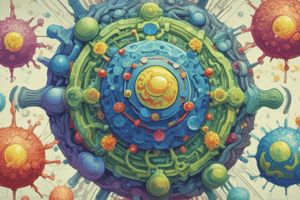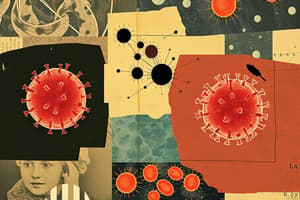Podcast
Questions and Answers
What is the primary function of the lymphatic system?
What is the primary function of the lymphatic system?
- To regulate blood pressure and heart rate
- To collect residual fluid, filter pathogens, and return fluid to circulation (correct)
- To transport oxygenated blood throughout the body
- To produce red blood cells and store platelets
Which feature allows the adaptive immune system to respond more effectively upon subsequent exposures to an antigen?
Which feature allows the adaptive immune system to respond more effectively upon subsequent exposures to an antigen?
- Memory (correct)
- Specificity
- Cytokine production
- Self tolerance
What is required for self tolerance in the adaptive immune system?
What is required for self tolerance in the adaptive immune system?
- Selectively allowing B and T cells to respond to self antigens
- Activation of all immune cells regardless of specificity
- Selection of antigen-specific B and T cell repertoires and post-selection regulation (correct)
- Continuous exposure to non-self antigens
Which type of cell is directly involved in presenting antigens to T cells?
Which type of cell is directly involved in presenting antigens to T cells?
What role does T cell interaction with B cells play in adaptive immunity?
What role does T cell interaction with B cells play in adaptive immunity?
What process allows antibodies to better recognize antigens?
What process allows antibodies to better recognize antigens?
Which function does NOT represent a role of antibodies?
Which function does NOT represent a role of antibodies?
Which type of T cell is primarily involved in cell-mediated immunity?
Which type of T cell is primarily involved in cell-mediated immunity?
What is the primary role of lymph nodes in adaptive immunity?
What is the primary role of lymph nodes in adaptive immunity?
How do NK cells identify infected or transformed cells?
How do NK cells identify infected or transformed cells?
Which type of cell is primarily responsible for mediating adaptive immunity?
Which type of cell is primarily responsible for mediating adaptive immunity?
Which type of antigen recognition is performed by B cells?
Which type of antigen recognition is performed by B cells?
What is the primary role of T cells in adaptive immunity?
What is the primary role of T cells in adaptive immunity?
Which pathway involves the presentation of exogenous antigens?
Which pathway involves the presentation of exogenous antigens?
What type of T cell is primarily involved in helping B cells differentiate?
What type of T cell is primarily involved in helping B cells differentiate?
What is a distinguishing feature of adaptive immunity compared to innate immunity?
What is a distinguishing feature of adaptive immunity compared to innate immunity?
Which of the following is NOT a role of B cells in adaptive immunity?
Which of the following is NOT a role of B cells in adaptive immunity?
What defines somatic recombination in lymphocytes?
What defines somatic recombination in lymphocytes?
Flashcards
Antibody Function
Antibody Function
Antibodies have various functions, including opsonization and complement activation, neutralizing toxins, and clearing microbes.
Somatic Hypermutation
Somatic Hypermutation
Process of modifying antibodies to better recognize antigens.
Antibody Isotype Switching
Antibody Isotype Switching
Change antibody tissue distribution and biological functions.
Adaptive Immunity (Cell Mediated)
Adaptive Immunity (Cell Mediated)
Signup and view all the flashcards
Antibody-Dependent Cell-Mediated Cytotoxicity (ADCC)
Antibody-Dependent Cell-Mediated Cytotoxicity (ADCC)
Signup and view all the flashcards
Lymphatic System Function
Lymphatic System Function
Signup and view all the flashcards
Adaptive Immunity Specificity
Adaptive Immunity Specificity
Signup and view all the flashcards
Adaptive Immunity Memory
Adaptive Immunity Memory
Signup and view all the flashcards
Self Tolerance
Self Tolerance
Signup and view all the flashcards
Key Players Adaptive Immunity
Key Players Adaptive Immunity
Signup and view all the flashcards
Adaptive Immunity
Adaptive Immunity
Signup and view all the flashcards
Lymphocytes (T & B cells)
Lymphocytes (T & B cells)
Signup and view all the flashcards
Antigen Recognition (B cells)
Antigen Recognition (B cells)
Signup and view all the flashcards
Antigen Recognition (T cells)
Antigen Recognition (T cells)
Signup and view all the flashcards
Antigen Presentation Pathways
Antigen Presentation Pathways
Signup and view all the flashcards
Exogenous Antigen Pathway
Exogenous Antigen Pathway
Signup and view all the flashcards
Endogenous Antigen Pathway
Endogenous Antigen Pathway
Signup and view all the flashcards
Helper T cell (CD4)
Helper T cell (CD4)
Signup and view all the flashcards
Study Notes
Adaptive Immunity I-III
- Adaptive immunity is mediated by lymphocytes (T cells, B cells, and NK cells).
- Three different types of lymphocytes
- B and T cells are antigen-specific with specialized receptors.
- Receptors are generated by somatic recombination.
Adaptive Immunity I: Key Objectives
- Distinguish lymphocytes mediating adaptive immunity from natural killer cells, myeloid lineage cells, and other hematopoietic cells.
- Describe how natural killer cells are linked with adaptive immunity.
- Differentiate mechanisms of antigen recognition between T and B lymphocytes.
- Distinguish exogenous and endogenous antigen presentation pathways.
- Describe the lymphatic system's contribution to adaptive immunity.
- List key features of adaptive immunity.
Key Cellular Elements of Adaptive Immunity
- Adaptive immunity is mediated by T cells, B cells, and NK cells.
- Lymphocytes are part of a larger family of leukocytes (white blood cells).
- B and T cells are antigen-specific and have diverse, specialized receptor repertoires generated by somatic recombination.
- Hematopoietic stem cells are found in bone marrow.
Antigen Recognition
- B cells recognize antigens in their free, native form (direct recognition).
- T cells recognize antigens (proteins) processed into linear peptides and presented with MHC molecules on antigen-presenting cells (associative recognition).
Two Distinct Pathways
- Antigen processing pathways are exogenous and endogenous.
- Two classes of MHC molecules (MHC I and MHC II) exist.
- Two classes of T cells exist (Helper T cells (CD4) and Cytotoxic T cells (CD8)).
Mechanisms of Adaptive Immunity (Humoral)
- B cells produce antibodies (humoral immunity) and function as antigen-presenting cells (APCs).
- Antibodies are antigen-specific receptors on B cell surfaces.
- The process begins as an intrinsic response, similar to a reflex.
- With T cell help, B cells differentiate to produce more antibodies, refine antigen recognition, and change antibody function (isotype switching).
- Immune response involves T-B cell co-operation and coordination.
Antibody Functions
- Antibody functions include opsonization, complement activation, toxin neutralization, and microbe neutralization.
Mechanisms of Adaptive Immunity (Cell-Mediated)
- T cells can kill infected or transformed cells exhibiting non-self or altered self-antigens (CD8+ cytotoxic T cells).
- T cells produce cytokines affecting other cell function (CD4+ T cells).
- Actions triggered by antigen-specific receptors interacting with MHC/peptide complexes.
- Natural killer (NK) cells lack antigen-specific receptors but can react to specific antigens through antibody bridges.
- NK cells mediate antibody-dependent cell-mediated cytotoxicity (ADCC) and release cytokines.
Lymphatic System
- Immune responses are initiated in lymph nodes via cell-to-cell interactions.
- Lymph nodes contain antigen-presenting cells that deliver antigens from the periphery.
- B cells reside in lymph nodes.
- T cells pass through lymph nodes.
- Multiple layers and pathways of cooperation are essential for adaptive immune system function.
Lymphatic System (Key)
- Low-pressure circulatory system collecting residual fluid and filtering pathogens from tissues.
- Empties into subclavian veins.
- Consists of lymphatic vessels, lymph nodes, bone marrow, spleen, thymus, and mucosa-associated lymphoid tissue.
Key Features of Adaptive Immunity
- Specificity: Responds to particular antigens and only that antigen.
- Memory: "Remembers" antigen for accelerated, stronger responses in subsequent exposures.
- Self-tolerance: Normally does not respond to self-antigens.
- Self-tolerance depends on antigen-specific B and T cell repertoire selection and post-selection regulation.
Summary
- Adaptive immunity involves T cells, B cells, NK cells, antigen-presenting cells, accessory cells, MHC molecules, antibodies, and cytokines.
- Interactions include T-T cell interactions; T cells-accessory cell interactions; T cells-APC interactions; T cells-B cell interactions; NK cells-Antibody interactions.
Studying That Suits You
Use AI to generate personalized quizzes and flashcards to suit your learning preferences.




